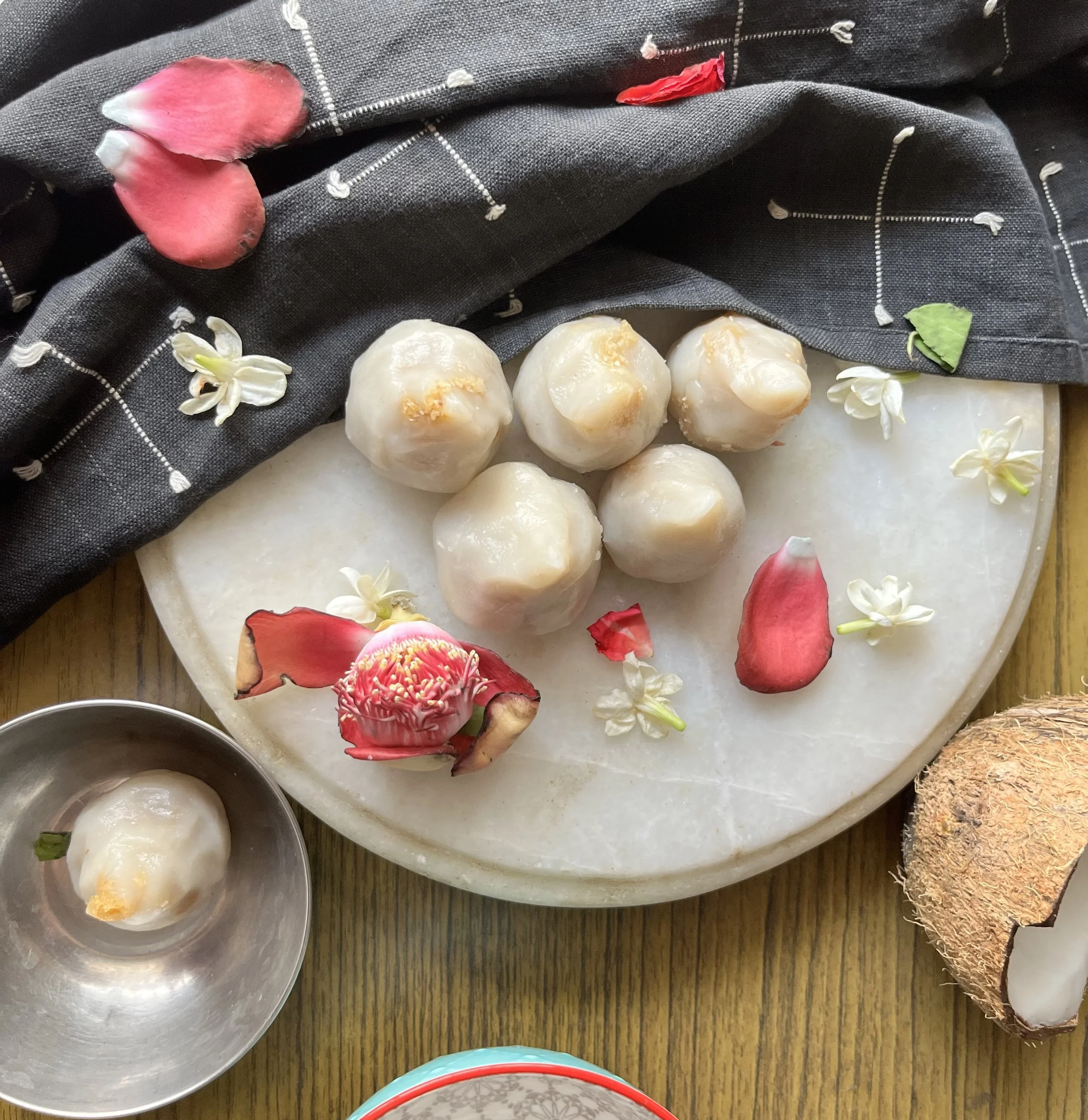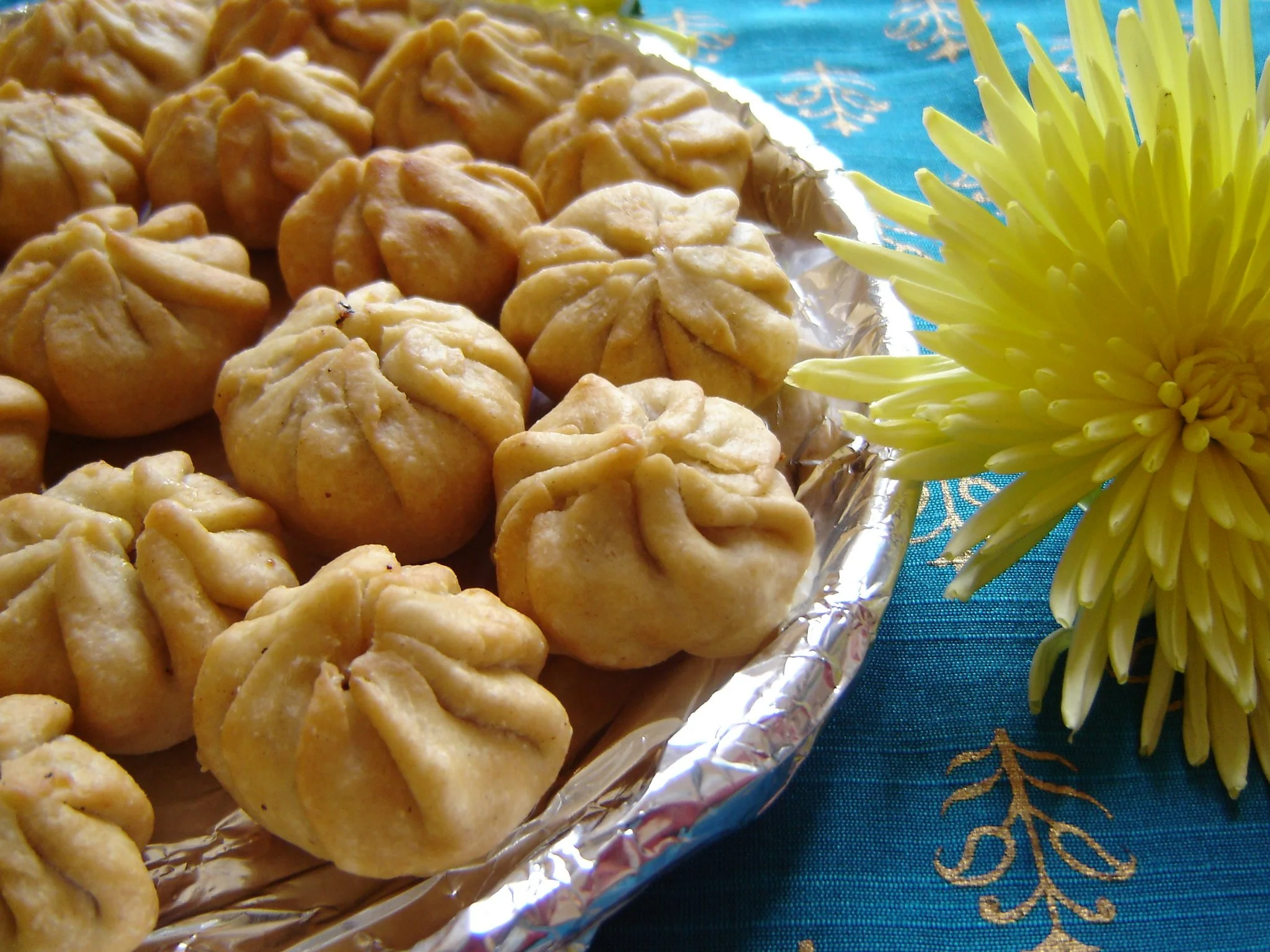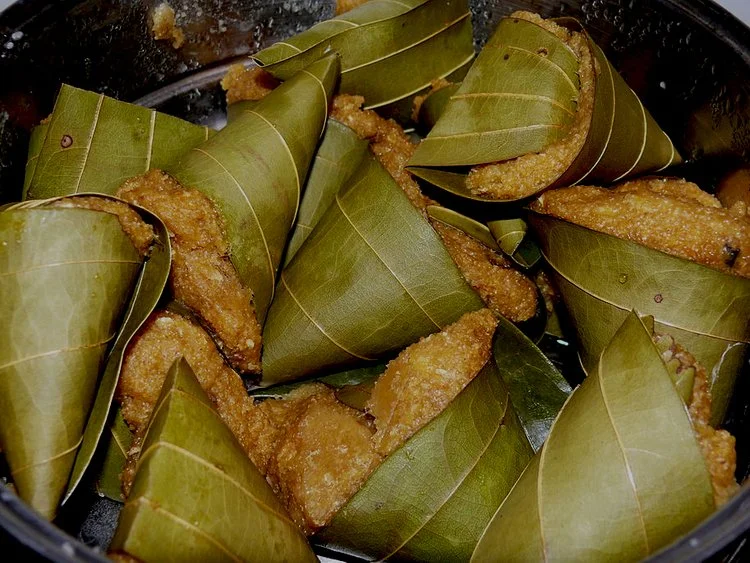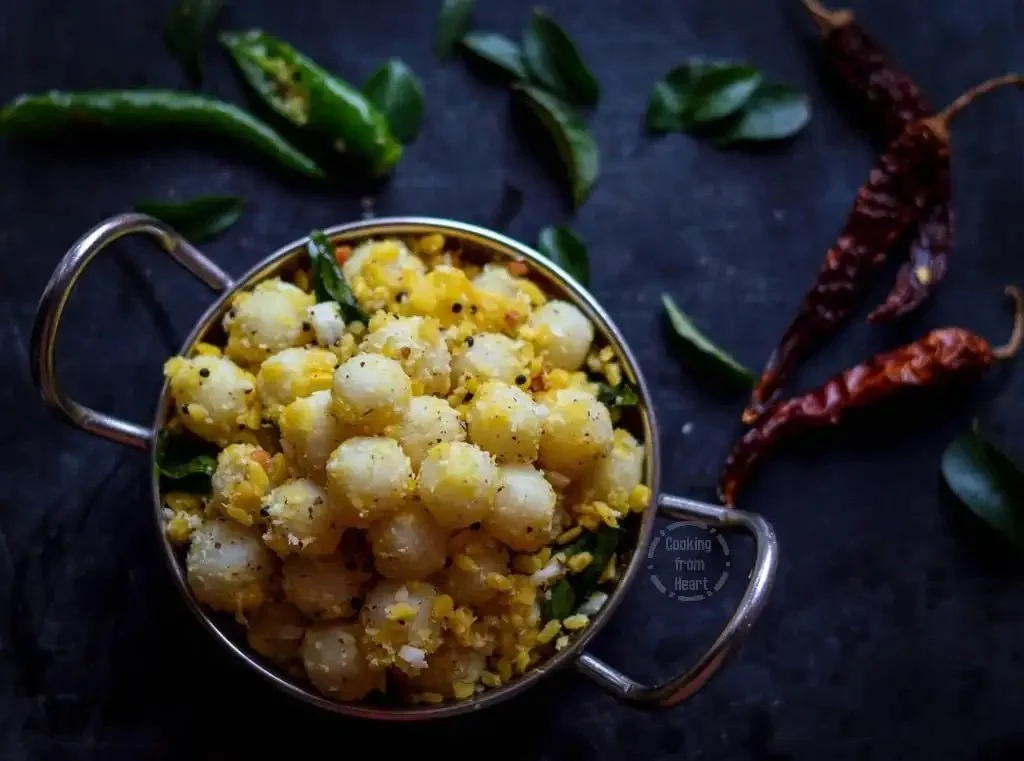The Learner’s Dumpling
By Apoorva Sripathi
Thengai poornam kozhukattais with a filling of coconut and jaggery. Photo courtesy of Apoorva Sripathi
Consider the dumpling as universal. One of the oldest, and possibly the precursor of many dumpling shapes and varieties, mantou is said to have originated in China during its Warring States Period, where three kingdoms wrestled for control over the ancient country. Another story suggests it finds mention in the medicinal cookbook, A Soup for the Qan, written by Hu Sihui for the Yuan Dynasty. The dynasty is credited with having spread the mantou around their empire, and subsequently, the world.
Today, there’s the manti in Central Asia, mandu in Korea, mataz in the North Caucasus, momos in Nepal and India. There are other dumplings: tamales, ravioli, kenkey, jiaozi, the knödel and its variants, and khinkali, among others. Then there are the fried/baked kind, like the samosa, empanada, knish, and the calzone. This isn’t an exhaustive list by any means, and I’m tempted to compile the “Big Book of Dumplings Around the World” to find out the range of this global dish, whose cultural synthesis has been shaped by regional foodways and transnational movements of food and the people who carried it from place to place.
The mantou is considered the precursor to many dumpling varieties and shapes. Photo credit: Aumrino970 — Own work, CC BY-SA 4.0, via Wikimedia Commons
But what makes a dumpling? Therein lies both the predicament and the answer; that there is no one blueprint for it. Simply put, they are parcels made of flour that are stuffed (or sometimes just rolled into balls) and then steamed, stir-fried, baked or deep-fried. They are smothered in oil or sauce, dunked in milk or folded in leaves. Every dumpling that we know as a dumpling rejects typecasting. Meatballs in sauce? Dumpling! McDonald’s apple pie? Fried dumpling!
While the kozhukattai doesn’t need emphasising, it is the dumpling that, like most south Indians, I grew up eating. My filling of choice is jaggery and coconut with a pinch of cardamom. Other fillings include powdered black sesame seeds with jaggery, chana dal and jaggery, savoury lentil and coconut, and jackfruit.
***
Regional variants come with their own names: what is kozhukattai (or mothagam) in Tamil is kozhukatta in Malayalam, kudumulu in Telugu, and kadubu in Kannada. All four variants share the same outer covering, made with ground rice batter or rice flour mixed with hot water (along with a pinch of salt and ghee/oil), if one is pressed for time. It’s what’s inside that varies, sweet or savoury.
What I most enjoy, besides eating them, is that there are no fancy folds with the kozhukattai. It is a learner’s dumpling, but also that of the expert. Proceed thus: grease your hands with coconut oil or ghee. Take the rice outer covering into a ball and slowly shape it into a cup by flattening the sides as thin as possible and lifting carefully. Place the desired filling into the cup, and bring everything together into a knot at the top and join. Or pinch the excess dough and shape it into a globe. Sometimes I press it into a half-moon shape, its sides lifted into a smile to reflect my mood while making them. Of course, you can just use a mould and grease it generously, saving yourself the trouble of making sure the covering doesn’t tear with each fold. It is the non-glutinous rice dough that poses a challenge, which is perhaps why there aren’t expert folds like you would find in Chinese dumplings that are made with wheat, a gluten powerhouse. This usage of rice extending to sweets not only points to how much the grain was prized but also to what the region consumed.
Which brings us to the pièce de résistance (usually) in the anthropology of what we eat: Where does the kozhukattai originate from if it’s eaten in south India? Chef and historian Shri Bala is sure that there’s no point in splitting hairs about where it’s from.
“Pre-independence, entire south India was one entity, along with Orissa,” she says. “We share a lot in common when it comes to food because migration took place between states.”
The making of a thengai poornam kozhukattai. Photo courtesy: Apoorva Sripathi
Was the kozhukattai always present then?
During Avvai Nombu, a ceremony to honour the 18th century poet Avvai, observed on Tuesdays in the Tamil months of Thai and Aadi in some parts of Tamil Nadu, women gather together, pray and sing, and prepare kozhukattai with pieces of coconut and coconut water. There are supposedly various benefits to this, from blessing the women with a happy family and good husbands to reinforcing their power and making wishes come true. Men are not allowed to take part, nor are they allowed to eat the kozhukattais.
Edgar Thurston and K. Rangachari allude to it in Castes and Tribes of Southern India: “A certain number of women club together, and provide the necessary rice, which is measured on the back of the hand… At the house where the ceremony is to be performed, the rice is pounded into flour, and mixed with leaves of Pongamia Glabra and Margosa. The mixture is then made into cakes, some flat, and some conical, to represent Pillayar [or the Lord Ganesh].”
Aadi pirappu, or the arrival of the month of Aadi in mid-July is also welcomed with kozhukkattai by Tamils in both India and Sri Lanka.
The poet Avvai finds a mention in the literature of the Sangam Period, which points to the ancient origins of the kozhukattai. Shri Bala agrees.
“The current way of presenting the kozhukattai—dough that is shaped into a cup, stuffed with pooran and steamed—is a refined version,” she says. “It could’ve been an influence from foreign countries. The pidi kozhukattai is the most ancient one; it’s in the name, pidi as shaped by hand.”
If one is to go by myths, then the kozhukattai has been present in the south for a longer time. Lord Ganesha is supposed to have gorged on kozhukattais (or modaks, as the folklore goes and as they are known in western India), which is why they are offered to him on Vinayagar Chaturthi (a ten-day festival observed to honour Ganesha’s birthday).
As kozhukatta, it is a regular fixture during the Kozhukatta Perunnal or Palm Sunday, observed by the Syrian Christians of Kerala. Commemorating Jesus’ entry into Jerusalem, the kozhukatta is supposed to represent the stones that were thrown on Jesus during his crucifixion, while the sweet stuffing of coconut and jaggery is said to represent love. In parts of Sri Lanka, a pallu (Tamil for tooth) kozhukattai ceremony is held when the child’s first tooth appears. A kozhukattai stuffed with a coin is dropped over the child’s head, which is used as the first teether.
There’s also the dateless bedtime story (different families have different versions, like the kozhukattai itself) about a silly man who comes across kozhukattai for the first time at a wedding feast, becomes obsessed, and in an effort to remember its name, constantly repeats “kozhukattai” to himself. While going back home, he sees a man jumping across a stream yelling “Athiribacha!” The silly man does the same and repeats “Athiribacha” while jumping across, but sustains an injury to his head, which swells up. Kozhukattai is now out of his memory and he repeats “athiribacha” till he reaches home, and asks his wife to make him some athiribacha. Confused as to what the dish is, he tries to recall it but in vain. They fight till she notices his head and asks angrily: “What is the swelling on your head like a kozhukattai?” A Eureka moment later, the silly man jumps up and exclaims, “That’s it, the kozhukattai.”
Who knew that the rather unpoetic form of the kozhukattai would serve as comic device, and metaphors in the Tamil language. The oft-uttered phrase, often in exasperation, is “வாயில் என்ன கொழுக்கட்டை வைத்திருக்கிறாய்”, which translates to “Do you have a kozhukattai in your mouth?” It is meant to inquire why one is silent when they are expected to answer.
Literary kozhukattais are rather deep, the opposite of their solid counterparts. Another saying goes, “கொழுக்கட்டைக்குத் தலையுமில்லை குடியனுக்கு முறையுமில்லை,” which translates to “The dumpling has no head and the drunkard has no relationship.” The original source of this adage is unknown, but it finds a mention in A Comprehensive Tamil and English Dictionary compiled by Miron Winslow, an American missionary to Sri Lanka and Chennai, which later became the basis for the Tamil Lexicon dictionary published by the University of Madras in 1924. I’ve pored over its etymology many times; like vazhaipazham (or banana), it is a difficult word to pronounce as well, both employing the retroflex consonant. Kozhu or kolu is fat/stuffed in Tamil, but it can also derive from koozh (there’s that retroflex consonant again!), which is a porridge that’s traditionally made from millets like ragi and bajra. According to Winslow’s dictionary, which has been catalogued in the Digital South Asia Library by the University of Chicago, it could also point to another meaning of kolu, which is the ploughshare. . Perhaps the sharp blade of the ploughshare is mimicked in the kozhukattai when shaped as a half-moon. Kattai is just a block, structure, or a bundle.
***
Talalele or fried modaks. Photo courtesy: Anupama — Own work, CC BY 4.0, via Flickr
In the stories, idioms and metaphors that it is a part of, the kozhukattai is not inconsequential; it cannot be replaced by anything else. Certainly not by its cousin, the modak. So which came first — the kozhukattai or the modak? It’s difficult to tell. Both are made out of rice flour, stuffed with coconut and jaggery, and steamed. But where they both differ is in their many avatars. Modaks can be made with both rice and wheat flour, can be steamed (ukadiche modak) and fried (talalele / talniche modak). Today, it’s filled with anything from khoya (or reduced milk solids) and dry fruits to ganache and marzipan.
But where modaks are lavish in their variations, kozhukattais are thrifty yet adaptable. They are stuffed with whatever is available seasonally or in the kitchen and then steamed. While the chakkapazha ada incorporates bits of jackfruit along with rice flour and jaggery and is steamed inside bay or banana leaves, the chakka kozhukatta is stuffed with jackfruit jam or jackfruit and grated coconut.
The ellu kozhukattai is made with the same rice outer covering but is stuffed with powdered black sesame seeds and jaggery. The paruppu kozhukattai can be both savoury and sweet. In the former version, soaked parboiled rice is ground into a batter, cooked with lentils, spices, and vegetables, moulded into cylinders by hand, and then steamed. Its sweet counterpart has soaked chana dal that has been cooked till mash, sweetened with jaggery syrup along with grated coconut and cardamom, rolled into small balls, and stuffed into the outer covering. Paal kozhukattai, also shaped into small balls, is boiled in water or in sweetened coconut milk and is presented like a pasta-meets-payasam dish.
Shri Bala says the paal kozhukattai mimics the techniques of pasta: “The dough is kneaded into small balls, put in hot water, and when aerated, the dumplings are strained to remove moisture and then dumped into the payasam. [This dish] probably has a foreign influence because the Chettiars travelled a lot”.
The Chettiars, a wealthy seafaring community, may have found the inspiration for this dish during their frequent travels.
***
Therali kozhukattais steamed in aromatic Indian bay leaves. Photo courtesy: Nanjil Vivek
This is by no means an exhaustive list.
The flat-shaped panai olai kozhukattai, made with palm jaggery and coconut and steamed in palm leaves, is made for the Tamil Hindu festival Karthigai Deepam, where oil lamps are lit everyday during the month of Kaarthikai. Therali kozhukatta makes use of the abundant Indian bay leaves (found in Alappuzha in Kerala, Nagercoil and Kanyakumari in Tamil Nadu). A coconut-jaggery filling (sometimes along with the Nendran banana), spiced with dry ginger and cardamom, is stuffed inside the leaf shaped into a cone. Its variation is the kumbilappam or the chakkayappam, which has jackfruit flesh added to the mix, made during the jackfruit season in Kerala.
The one fried anomaly in the mothagam/kozhukattai matrix is the suzhiyan (also known as suyyam/sukhiyan/susiyam/poornalu/boorelu), a deep-fried sweet that is filled with either coconut and jaggery or sweetened lentils. The outer covering changes to either a rice-urad dal batter or a rice and maida/all purpose flour batter. The batter and filing ingredients vary from household to household. In mine, for example, we add some semolina to the mix. Usually consumed during Deepavali, suzhiyan is also a popular evening snack. In some households, it is prepared for funerals.
Ammini kozhukattais are made using leftover rice dough that is tempered with spices. Photo courtesy: Ramya
The kozhukattai’s savoury versions are simpler still. Ammini kozhukattai is made using leftover steamed rice dough that’s shaped into small balls and tempered with mustard seeds and curry leaves. Pidi kozhukattai (Tamil for “hold its shape”) is shaped by pressing the dough between the hand, taking on the contours of one’s fingers.
Upma kozhukattai—a variation on the eponymous breakfast dish made of semolina— is made with washed and dried rice turned into grits, which is tempered with dried red chillies, asafoetida, peppercorns, cumin, and mustard seeds. This mixture is then rolled into tight dumplings and steamed. Ulundhu kozhukattai or the uppu kozhukattai made for Vinayagar Chaturthi is sometimes shaped like an empanada, and is filled with urad dal spiced with green chillies, salt, and grated coconut. Newfound versions include oats, corn, and bread kozhukattai.
***
Trends may come and go, but this humble dumpling gently trudges on. Chef Regi Mathew, the co-owner and culinary director of the restaurant Kappa Chakka Kandhari in Chennai and Bengaluru, remembers kozhukattai as his most favourite food.
“Kozhukatta has always excited me since childhood,” he says. “It’s not a special dish for me, I eat it almost weekly at home. And the chakkapazha ada [made of jackfruit] is my favourite.”
Mathew tells me about the other variations found in Kerala, including the unda puttu that is stuffed with prawns and rolled in coconut; a kozhukatta made with wheat, another that is made with freshly harvested rice, and a kozhukatta stuffed with chicken which is a traditional Ramzan offering.
Kozhukattais are snack food — convenient, satiating, and nutritious. British-Sri Lankan chef and author Cynthia Shanmugalingam, who is behind the Sri Lankan restaurant Rambutan in London, is happy to talk about her love for kozhukattai. She anoints them as “Tamil mochi.”
“I LOVE them, but they’re a bit fiddly [to make],” she says. “To be honest, I’d like to eat one every single day, maybe 3. Sometimes I make just the filling and eat it.”
In the hierarchy of Indian mithai, the versatile kozhukattai is nowhere to be found. There is no syrup oozing from it delectably, it isn’t studded with heaps of nuts and dry fruits, and no countless cups of ghee have gone into its making. It can be both vegan and gluten-free – a dish for our times. Found in innumerable varieties, the kozhukattai is just another extension of rice, an everyday grain for most Indians, reflecting many cultures, symbols, traditions, and practices, whether ritual or agricultural.
There’s no eloquence about the kozhukattai, not when you write about it or when you make it. The point of it lies in its flexible existence: coconut or black sesame, lentils or jackfruit, chicken or prawn. Suspended in thick, sweet payasam. To each their own, as they say. This is simply mithai for the soul.






